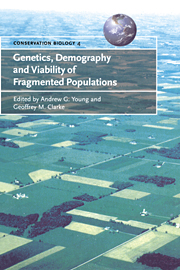Book contents
- Frontmatter
- Contents
- List of contributors
- Foreword by Peter F. Brussard
- Preface
- 1 Introduction: genetics, demography and the conservation of fragmented populations
- Part I Introductory concepts
- Part II Animal case studies
- Part III Plant case studies
- 14 Limited forest fragmentation improves reproduction in the declining New Zealand mistletoe Peraxilla tetrapetala (Loranthaceae)
- 15 Ecology and genetics of Grevillea (Proteaceae): implications for conservation of fragmented populations
- 16 Genetic and demographic influences on population persistence: gene flow and genetic rescue in Silene alba
- 17 Fragmentation in Central American dry forests: genetic impacts on Swietenia humilis (Meliaceae)
- 18 Population viability analysis of the rare Gentiana pneumonanthe: the importance of genetics, demography and reproductive biology
- 19 Genetic erosion, restricted mating and reduced viability in fragmented populations of the endangered grassland herb Rutidosis leptorrhynchoides
- 20 Conclusions and future directions: what do we know about the genetic and demographic effects of habitat fragmentation and where do we go from here?
- References
- Index
14 - Limited forest fragmentation improves reproduction in the declining New Zealand mistletoe Peraxilla tetrapetala (Loranthaceae)
Published online by Cambridge University Press: 29 January 2010
- Frontmatter
- Contents
- List of contributors
- Foreword by Peter F. Brussard
- Preface
- 1 Introduction: genetics, demography and the conservation of fragmented populations
- Part I Introductory concepts
- Part II Animal case studies
- Part III Plant case studies
- 14 Limited forest fragmentation improves reproduction in the declining New Zealand mistletoe Peraxilla tetrapetala (Loranthaceae)
- 15 Ecology and genetics of Grevillea (Proteaceae): implications for conservation of fragmented populations
- 16 Genetic and demographic influences on population persistence: gene flow and genetic rescue in Silene alba
- 17 Fragmentation in Central American dry forests: genetic impacts on Swietenia humilis (Meliaceae)
- 18 Population viability analysis of the rare Gentiana pneumonanthe: the importance of genetics, demography and reproductive biology
- 19 Genetic erosion, restricted mating and reduced viability in fragmented populations of the endangered grassland herb Rutidosis leptorrhynchoides
- 20 Conclusions and future directions: what do we know about the genetic and demographic effects of habitat fragmentation and where do we go from here?
- References
- Index
Summary
ABSTRACT
Fragmentation may disrupt mutualisms such as pollination or dispersal, adding indirect negative effects on native plant species to the direct effects of habitat loss. However the effect of fragmentation on mutualisms has been studied only rarely. Here we show that a limited degree of fragmentation improves reproduction in the endemic mistletoe Peraodlla tetrapetala (Loranthaceae) in New Zealand.
P. tetrapetala has declined since European settlement 150 years ago; the decline has been attributed partly to weakened pollination and dispersal mutualisms. The decline of native honeyeaters (Aves: Meliphagidae) has caused strong pollen-limitation for P. tetrapetala at some sites. A native lepidopteran, Zelleria maculata, also limits reproduction by destroying more than half the flower buds in some populations.
Here we report that flower predation by Z maculata decreased and bird pollination increased with fragmentation over four sites at Lake Ohau, South Island. Flower predation decreased from 48% in continuous forest to 8% on isolated trees. Pollination was lowest in forest (14% seed set) and highest on isolated trees (45%). Fruit set therefore increased 4.4-fold with fragmentation. Plant density was also 2-3 times higher on fragment edges. Dispersal was good at all sites.
Therefore, P. tetrapetala seems to benefit from the forest edges created by fragmentation, provided that enough forest habitat survives to maintain bird densities. High levels of fragmentation beyond those measured here could possibly result in abrupt failures in the mutualisms. The benefits of moderate levels of fragmentation may partially offset declines in mistletoe numbers from habitat loss and introduced herbivores, which means that small fragments may still be of high value for mistletoe conservation.
- Type
- Chapter
- Information
- Genetics, Demography and Viability of Fragmented Populations , pp. 241 - 252Publisher: Cambridge University PressPrint publication year: 2000
- 10
- Cited by

